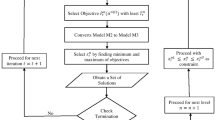Abstract
This paper addresses classes of assembled printed circuit boards, which faces certain kinds of errors during its process of manufacturing. Occurrence of errors may lead the manufacturer to be in loss. The encountered problem has two objective functions, one is fractional and the other is a non-linear objective. The manufacturers are confined to maximize the fractional objective and to minimize the non-linear objective subject to stochastic and non-stochastic environment. This problem is decomposed into two problems. A solution approach to this model has been developed in this paper. Results of some test problems are provided.
Similar content being viewed by others
References
Charles, V., D. Dutta, and K. Appal Raju. (2001). “Linear Stochastic Fractional Programming Problem.” In Bani Singh, U.S. Gupta, G.S. Stivastava, T.R. Gulati, and V.K. Katiyar (eds.), Proceedings of International Conference on Mathematical Modelling: New Delhi: Tata McGraw-Hill Publishing Ltd.
Charles, V., and D. Dutta. (2001). “Linear Stochastic Fractional Programming with Branch-and-Bound Technique.” In R. Nadarajan, and P.R. Kandasamy (eds.), Proceedings of National Conference on Mathematical and Computational Models: Chennai: Allied Publishers Ltd.
Charles, V., and D. Dutta. (2003). “Bi-Weighted Multi-Objective Stochastic Fractional Programming Problem with Mixed Constraints.” In R. Nadarajan, and G. Arulmozhi (eds.), Proceedings of Second National Conference on Mathematical and Computational Models: Chennai: Allied Publishers Ltd.
Charnes, A., and W.W. Cooper. (1954). “Chance Constrained Programming.” Management Science 6.
Charnes, A., and W.W. Cooper. (1962). “Programming with Linear Fractional Functions.” Naval Research Logistic Quarterly 9, 181–186.
Cheney, E.W., and A.A. Goldstein. (1959). “Newton's Method of Convex programming and Tchebycheff Approximation.” Numerische Methematik 1, 253–268.
Dutta, D., J.R. Rao, and R.N. Tiwari. (1993). “A Restricted Class of Multi Objective Linear Fractional Programming Problems.” European Journal of Operational Research 68, 352–355.
Eschenauer, H., J. Koshi, and A. Osyczka. (1990). Multicriteria Design Optimization Procedures and Applications. New York: Springer Verlag.
Gupta, S.N., and Kanti Swarup. (1979). “Stochastic Fractional Functionals Programming.” Ricerca Operativa, Franco Angeli-anno IX-nuova Serien 10, 65–78.
Gupta, S.N., Kanti Swarup, and Banwarilal. (1981). “Stochastic Fractional Programming with Random Technology Matrix.” Gujarat Statistical Review VIII, 23–34.
Im Stancu-Minasian, and M.J. Wets. (1976). A Research Bibliography in Stochastic Programming 1955–1975: CORE Discussion Papers 7603. Belgium: University Catholique de Louvain.
Im Stancu-Minasian. (1977). Bibliography of Fractional Programming 1960–1976. Preprint nr.3, Department of Economic Cybemetics, Bucharest: ASE.
Jeeva, M., R. Rajalakshmi, and V. Charles. (2002). “Stochastic Programming in Manpower Planning—Cluster Based Optimum Allocation of Recruitments.” In J.R. Artalejo, and A. Krishnamoorthy (eds.), Advances in Stochastic Modelling: New Jersey: USA: Notable Publications, Inc.
Jeeva, M., R. Rajalakshmi, V. Charles, and V.S.S. Yadavalli. (2004). “An Application of Stochastic Programming with Weibull Distribution—Cluster Based Optimum Allocation of Recruitments in Manpower Planning.” Journal of Stochastic Analysis and Applications 22 (3), 801–812.
Kelly, J.E. (1960). “The Cutting Plane for Solving Convex Programs.” Journal of SIAM VIII (4), 703–712.
Martel, A., and W. Price. (1981). “Stochastic Programming Applied to Human Resource Planning.” North Holland: Operational Research Society 32, 187–196.
Rao, S.S. (1984). “Multiobjective Optimization in Structural Design in the Presence of Uncertain Parameters and Stochastic Process.” AIAA Journal 22, 1670–1678.
Rao, S.S., and H.R. Eslampour. (1986). “Multistage Multiobjective Optimization of Gearboxes.” ASME Journal of Mechanisms, Transmissions & Automation in Design 108, 461–468.
Zionts, S. (1968). “Programming with Linear Fractional Functionals.” Naval Research Logistic Quarterly 15, 449–451.
http://users.iems.nwu.edu/jrbirge/html/dholmes/SPTSlists.html.
http://mally.eco.rug.nl/biblio/Splist.html.
Author information
Authors and Affiliations
Corresponding author
Rights and permissions
About this article
Cite this article
Charles, V., Dutta, D. Extremization of multi-objective stochastic fractional programming problem. Ann Oper Res 143, 297–304 (2006). https://doi.org/10.1007/s10479-006-7389-7
Issue Date:
DOI: https://doi.org/10.1007/s10479-006-7389-7



